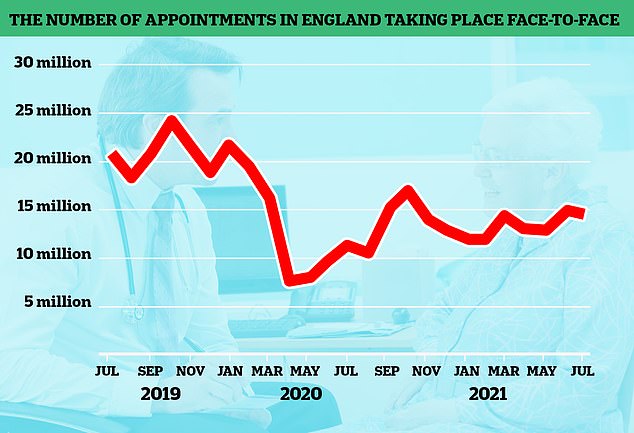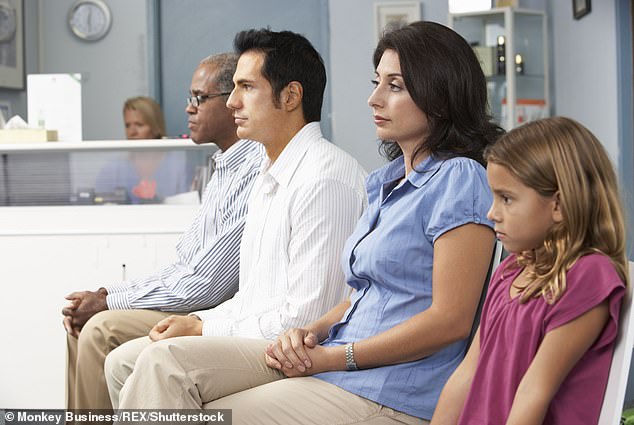The average GP is now working a three-day week following a startling drop in working hours, as official figures reveal the average number of people per family doctor has risen 5 per cent to 2,038 over the past six years.
Research commissioned by the Department of Health show that GPs carried out just 6.6 half-day sessions a week – the equivalent of just over three days – in 2019, the lowest on record. In 2010, it was 7.5 sessions.
The data, seen by the Daily Telegraph, also shows a fall in the proportion of time spent on ‘direct patient care’, with just 59 per cent of GPs’ time being spent in this way in 2019 – down from 63.1 percent in 2010.
The National GP Worklife Survey of 1,332 GPs, carried out by the University of Manchester, shows that the average number of weekly hours ‘decreased significantly’ between 2017 and 2019, the paper reported.
And rising earnings saw average GP pay top £100,000 before tax and expenses in 2019-20, NHS statistics show – amid mounting concern about difficulties in obtaining face-to-face appointments with a GP.
Before the Covid pandemic, arounds 80 per cent of consultations took place in a doctors surgery – but in August this year the figure was just 57.7 per cent. However, patients are enduring a ‘postcode lottery’, with the worst-hit areas of the country served by half as many GPs as the best. The NHS is battling a soaring backlog, with the Government admitting the record waiting list for hospital treatment will worsen before it gets better and could reach a massive 13million.
The shocking figures will put fresh pressure on ministers to tackle poor access to face-to-face appointments and treatment, as a string of deaths suggests that cancer and other serious illnesses are being missed because so many consultations are now carried out by phone or video.
Dennis Reed, the director of Silver Voices, a campaign group for the over-60s, told the Telegraph: ‘The situation is really worrying. It’s hardly surprising that we are facing a national crisis in terms of face-to-face access to GPs when the average doctor is only working a three-day week.

Patients are enduring a postcode lottery, with the worst-hit areas of the country served by half as many GPs as the best as population increases and lack of doctors is blamed for the disparity

The number of GP appointments taking place face-to-face dropped dramatically at the beginning of the pandemic, as virtual appointments were encouraged in an attempt to keep social mixing low and hospitals virus-free. In-person appointments began to increase last summer, before dropping again during the second wave. Despite being on the rise, the figures are still much lower than pre-pandemic levels

Graph shows: The number of people waiting to see a cancer doctor in the UK jumped from just over 5,000 at the start of the pandemic to nearly 30,000 in June this year
Lung cancer and mental health issue diagnoses ‘still virtual’
People with lung cancer and mental health issues are still not getting diagnoses in person.
The Mail is campaigning for more face-to-face GP consultations, but there is also evidence from around the country that some patients are still unable to see hospital consultants and mental health experts in person.
In one case a man was told in a call that he had a year to live, the health scrutiny committee of Wakefield Council in West Yorkshire was told. He has since received an apology.
Another patient was told remotely she had lung cancer and one woman was misdiagnosed with Parkinson’s over the phone.
Meanwhile a mother from Bridgend in Wales who attempted suicide and was sectioned in 2019 has not had a face-to-face appointment in 18 months.
Aimee, 29, told the BBC: ‘All my treatment has been solely over the phone with a GP.’
A Welsh government spokesman said it was investing £42million this year into improving mental health and wellbeing.
Advertisement
‘It worries me that when we spend all this money and time training doctors they are able to work part-time, and for many of them that means using that time to work in private practice or doing locum work.’
The GP data comes from an analysis by House of Commons Library staff for the Liberal Democrats.
Mr Reed added: ‘These figures that have been uncovered are probably one of the main reasons why there is such a postcode lottery over face-to-face appointments.’ He called on the Department of Health to review GP contracts to ensure that doctors were working sufficient hours and in all areas of the country.
‘It shouldn’t just be left to chance as to whether you live in an area with good coverage or not,’ he said.
‘There should be some sort of incentive whereby GPs are encouraged to go where there’s very low coverage, and others could be incentivised to come out of retirement.’
The average number of people per family doctor has risen 5 per cent to 2,038 over the past six years, but in some areas the figure is nearly 3,000 – a stark contrast to the best-provided districts which have just 1,600 patients per GP. High population growth and a shrinking health workforce are behind the huge disparities.
Excluding trainees, the number of family doctors fell by 1 per cent from 28,115 in September 2015 to 27,752 this June. At the same time the population of England has increased by 3.2 per cent.
In Fylde and Wyre, Lancashire, there are 2,833 patients per GP, the highest ratio in the whole of England.
The next most over-stretched area is Hull with 2,761 people per family doctor. The 36 per cent rise there over five years is blamed on the number of local doctors plummeting.
Portsmouth has seen the sharpest rise in patients – 40 per cent – meaning there are now 2,559 per doctor in the city. The best ratio in the country was in Liverpool, with 1,614 people per GP, followed by Oxfordshire and Wirral.
In Fylde and Wyre just 69 GPs have to cater for a population of 195,906 but in Liverpool 310 of them serve 500,474.
Separate figures from the British Medical Association show that the number of fully-qualified GPs has dropped by 1,803 since 2015. Many have quit or switched to part-time or locum work ‘to avoid stress, ill-health and burnout’. Even the number of surgeries has dropped, partly because of mergers but also through staffing issues.
Munira Wilson, Liberal Democrat health spokesman, said: ‘This postcode lottery is leaving our hard-working GPs overstretched and patients waiting too long for treatment.

The NHS is battling a soaring backlog with the Government admitting the record waiting list for hospital treatment will worsen before it gets better and could reach a massive 13million
Lack of face-to-face appointments may have led to an 88% spike in stillbirths in England during pandemic, damning report finds
A lack of in-person appointments during the pandemic may have led to a surge in stillbirths, a damning report has warned.
The Healthcare Safety Investigation Branch said stillbirths were up 88 per cent last year compared to pre-Covid levels.
Its investigation into 37 cases found the move to remote appointments ‘impeded’ medics’ ability to carry out vital checks.
It comes after a senior coroner last week ruled that a lack of face-to-face GP appointments contributed to the deaths of five people.
A third fewer people are seeing their GP in-person now compared to before the pandemic and tens of millions of appointments were ‘lost’ during the Covid crisis.
GPs were urged to conduct all consultations remotely and strongly encouraged not to invite patients for an in-person appointment unless they deemed it an emergency.
But trusts have continued to incentivise the practice more than a year after the original lockdown, with doctors being offered bonuses to keep attendances low.
Health Secretary Sajid Javid fired a warning shot at GPs in the Commons earlier this week, telling them: ‘GPs should be offering face-to-face access.’
Advertisement
‘It’s clearer than ever that the Government needs to boost funding, train more doctors and get people the service they deserve. The Government is letting down patients who deserve a fair deal.’
Dr Richard Vautrey of the BMA said: ‘These figures clearly highlight the serious pressure that is being placed upon general practice at present, as the shortage of GPs alongside a large increase in demand means that many practices are struggling.
‘In many parts of the country it is very difficult to recruit and retain sufficient GPs, practice nurses and other staff.
‘This then adds further pressure on an already overburdened workforce, with the risk of burnout and some leaving the profession altogether.’
A 2019 league table from the Organisation for Economic Co-operation and Development ranks Britain 22nd worldwide, with an average of three physicians per 1,000. This puts the UK below most European nations as well as Russia and Australia.
The list is topped by Austria with 5.3 physicians per 1,000.
Ahead of the last election the Conservatives promised to get 6,000 more doctors in general practice by 2025. A previous pledge to get 5,000 more by 2020 was not met.
Last month, the head of Britain’s family doctors, Professor Martin Marshall, said he did not expect a return to the previous levels of face-to-face appointments, describing the current split as ‘about right’.
He said it was not his job to ask fellow medics to work more sessions, saying the model of a full-time GP was ‘probably something we won’t see again’. Surveys of trainee doctors have found that just one in 20 trainees intends to work full time.
Health Secretary Sajid Javid has held talks with the British Medical Association and Royal College of GPs about how to improve access to doctors, as officials examine ways to reduce unnecessary bureaucracy to free up GPs to see more patients. Ideas under discussion include having pharmacies take on more of their workload.
More than 900 GP practices with the longest waits to see a family doctor have already been ordered to improve access amid concern that too many patients are struggling to get the help they need.
An NHS spokesman told the Telegraph that ‘record numbers of people are now training to become GPs, with up to 4,000 new starters this year and rising investment in general practice means that there is funding for 26,000 additional primary care staff by March 2024’.
A Department of Health spokesman added: ‘We are clear GP practices must take the preference of the patient on board and provide face-to-face appointments to those who want them, alongside remote consultations. We have provided £270million to expand GP capacity on top of investing £1.5billion to the sector until 2023/24 to deliver world-class care to patients.’
Source link : https://www.dailymail.co.uk/news/article-10079147/Average-GP-working-three-day-week-one-2-000-patients.html











